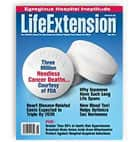 | June 3, 2011 | How deficiencies of selenium and other micronutrients can increase the risk of age-related disease | | In the June, 2011 issue of the FASEB Journal, Bruce N. Ames, PhD and Joyce C. McCann, PhD of California's Children's Hospital Oakland Research Institute reveal why modest deficiencies of any vitamin or mineral can increase the incidence of age-related disease. Readers of Life Extension Update may recall the September 25, 2009 issue which discussed Dr Ames' triage hypothesis. The hypothesis proposes that the body evolved to allocate frequently scarce micronutrients to short term survival or reproductive functions rather than to those that are protective of long term health. This phenomenon results in increasing damage to the tissues with nutrient deficiency, which elevates disease risk. Dr Ames' hypothesis was supported by an analysis of vitamin K dependent proteins, reported in the American Journal of Clinical Nutrition in October, 2009. The current review evaluates the effect of selenium deficiency on 12 of 25 known selenoproteins. Five of these selenium-dependent proteins are considered essential from an evolutionary perspective and seven are nonessential. Drs McCann and Ames found that modest selenium deficiency results in the loss of nonessential selenoprotein activities and concentrations, with the exception of one nonessential protein which they predict is conditionally essential. Mutations in selenoproteins lost with deficiency were discovered to result in characteristics in common with diseases that occur with aging. "The same set of age-related diseases and conditions, including cancer, heart disease, and immune dysfunction, are prospectively associated with modest selenium deficiency and also with genetic dysfunction of nonessential selenoproteins, suggesting that selenium deficiency could be a causal factor, a possibility strengthened by mechanistic evidence," the authors write. "Modest selenium deficiency is common in many parts of the world; optimal intake could prevent future disease." "Understanding how best to define and measure optimum nutrition will make the application of new technologies to allow each person to optimize their own nutrition a much more realistic possibility than it is today," noted Dr McCann, of the Children's Hospital Oakland Research Institute's Nutrition and Metabolism Center. "If the principles of the theory, as demonstrated for vitamin K and selenium, can be generalized to other vitamins and minerals, this may provide the foundation needed." "This paper should settle any debate about the importance of taking a good, complete, multivitamin every day," concluded FASEB Journal's Editor-in-Chief Gerald Weissmann, MD. "As this report shows, taking a multivitamin that contains selenium is a good way to prevent deficiencies that, over time, can cause harm in ways that we are just beginning to understand." | |  |  | | The National Cancer Institute (NCI) and the American Cancer Society (ACS) estimate that 22,020 primary malignant brain tumors will be diagnosed in 2010 (Porter KR et al 2010). The American Brain Tumor Association, since they count both malignant and benign brain tumors, predicts twice as many cases (Jemel A et al 2008). Secondary brain tumors, which originate elsewhere in the body, outnumber primary tumors four-to-one, so add another 100,000 cases a year to get an idea of the total number of people who will be diagnosed with brain cancer each year (Davis FG et al 2001). Melatonin is often suggested for treating various forms of cancer, particularly breast, lung and colorectal cancers. Lissoni has conducted repeated studies demonstrating that patients with advanced cancers given melatonin survive longer than patients receiving a placebo (Lissoni P et al 2007). Selenium is another antioxidant that patients with brain tumors should consider. Many oncologists fear that any nutritional supplement classified as an antioxidant will interfere with the ability of radiation or chemotherapy to kill cancer cells. Though this theory sounds logical, there is little published evidence to support it. In the case of selenium, a 2004 paper in the journal Anticancer Research, reports a “radiosensitizing effect” on glioma cells (Schueller P et al 2004). Exposing brain cancer cells to selenium makes them more sensitive to, and more likely to die after, radiation therapy. Selenium also inhibits growth and invasion, and induces apoptosis in various types of brain tumor cells, including malignant cell lines (Sundaram N et al 2000, Rooprai HK et al 2007). | 

Life Extension Magazine is the monthly publication of the Life Extension Foundation®. Members of Life Extension® receive the magazine free in addition to their other membership benefits. Life Extension is the first to report new discoveries involving nutrition, hormones, and anti-aging supplements, including such news-making items as coQ10 and omega-3 fatty acids. In addition, Life Extension reports innovative findings concerning the diseases that threaten many of us, such as atherosclerosis, cancer and diabetes. With each issue, subscribers to Life Extension Magazine receive potentially life-saving information they won’t find in most other publications. | |  |   | | Scientists have known for years that certain biological components of whey protein (including lactoferrin, beta-lactoglobulin, alpha-lactalbumin, glycomacropeptide, and immunoglobulins) have a beneficial impact on the immune system. Life Extension has developed a specially designed whey protein, using proprietary production methodology, that has been shown to support healthy immune function, protect against free radical attack, and help maintain lean muscle mass. | | | Durk Pearson & Sandy Shaw's Dual C Capsules   | | Fat-soluble vitamin C (ascorbyl palmitate) may be as important as water-soluble vitamin C, yet most vitamin consumers have not even heard of ascorbyl palmitate. If you take Life Extension Mix™, you are receiving an ample dose of fat-soluble ascorbyl palmitate. Each capsule of Dual-C contains 677 mg of fully reacted calcium ascorbate (gentle on the stomach and supplies calcium) and ascorbyl palmitate (to protect fat tissues from oxidation). | | | |  | | Life Extension Update | | What's Hot | | Life Extension® Magazine | |

